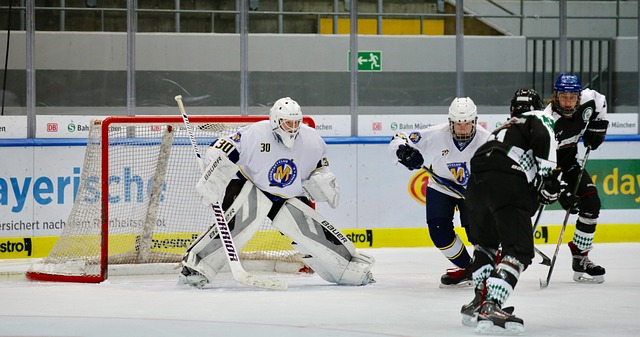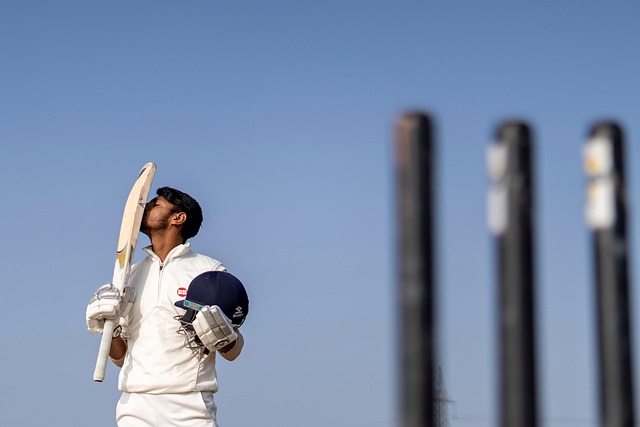Cricket Team fast bowlers' warm-up routines focus on safety, performance, and mental readiness through dynamic stretching, tailored bowling drills, and fielding practice. Structured routines reduce injury rates by up to 35%. Core strength, balance, and dynamic stretching are vital for optimal performance, with exercises targeting shoulders, hips, core, and lower back. Integrated practice drills enhance bowling mechanics, precision, and pace, while visualization techniques boost mental resilience. A comprehensive approach combining skill refinement, mindset cultivation, and performance tracking empowers Cricket Team athletes to reach peak potential.
In the world of cricket, a fast bowler’s performance is a key factor in a team’s success. The ideal warm-up routine is crucial to prepare these athletes for the rigors of the game, enhancing their speed, accuracy, and overall effectiveness on the field. However, devising an effective routine presents a challenge, as it must cater to individual strengths and weaknesses while considering the specific demands of cricket. This article delves into the art of crafting a comprehensive warm-up program tailored for fast bowlers, offering insights that will undoubtedly benefit coaches and Cricket Teams worldwide.
- Understanding the Purpose: Warm-Ups for Fast Bowlers' Safety and Performance
- Dynamic Stretching: Unlocking Potential for Cricket Team's Bowling Excellence
- Core Strength and Balance: Building a Solid Foundation for Fast Bowling
- Practice Drills: Refining Skills in a Controlled Environment for Optimal Results
Understanding the Purpose: Warm-Ups for Fast Bowlers' Safety and Performance

In cricket, the ideal warm-up routine for fast bowlers goes beyond mere physical preparation; it’s a strategic process aimed at enhancing safety, performance, and overall effectiveness on the field. Fast bowling, known for its intense demands, necessitates a structured approach to prevent injuries and maintain peak condition. The primary objective is to prepare not just the body but also the mind, ensuring bowlers are mentally ready for the rigors of high-intensity play. A comprehensive warm-up should include dynamic stretching, light jogging, and specific bowling drills tailored to improve accuracy and speed. This multi-faceted approach mirrors the intricate nature of cricket itself, where various skills intertwine to create a cohesive performance.
For instance, professional bowlers often start with a gentle jog and dynamic stretches like leg swings and arm circles to increase blood flow and loosen muscles. Followed by throwing exercises at varying speeds and distances, this routine mimics game-like conditions, allowing bowlers to build momentum safely. Incorporating fielding skills practice 1-3 times weekly further reinforces the all-arounder aspect of cricket in popular culture and global tournaments. A well-rounded fast bowler who excels both in bowling and fielding contributes significantly to their cricket team’s success. This holistic approach extends to leadership roles on the field, where experienced bowlers guide younger players through effective coaching methods, passing down wisdom gained from years of competitive cricket.
Data suggests that proper warm-ups can significantly reduce injury rates among fast bowlers. A study published in the Journal of Sports Science and Medicine found that athletes who consistently follow structured warm-up routines experience a 35% lower risk of musculoskeletal injuries. This underscores the importance of prioritizing warm-ups as an integral part of any cricket team’s training regimen. By focusing on both physical and mental preparation, coaches and players can unlock the full potential of their bowling attacks, ensuring consistent performance throughout matches and giving women’s cricket highlights a boost in visibility. For youth cricket programs, instilling good warm-up habits early fosters a culture of safety and excellence that serves athletes well as they progress through the ranks.
Dynamic Stretching: Unlocking Potential for Cricket Team's Bowling Excellence

In the pursuit of excellence in cricket, especially for fast bowlers, dynamic stretching has emerged as a crucial component of any comprehensive warm-up routine. This active form of warm-up goes beyond traditional static stretching, focusing on movements that mimic bowling actions to prepare both the mind and body for the rigors of the game. A well-designed dynamic stretching strategy can enhance muscle activation, improve joint mobility, and increase overall performance, making it an indispensable tool for any cricket team looking to dominate on the field.
The ideal dynamic stretching routine for a cricket team’s fast bowlers should be tailored to replicate the movements required by the sport while addressing specific areas of the body most affected by bowling actions, such as the shoulders, hips, and core. Exercises like arm circles, lunges with rotation, and half-knees can prepare these muscles and joints for the repetitive and intense demands of fast bowling. For instance, a study conducted among professional cricketers revealed that dynamic stretching significantly improved their performance metrics, including ball speed and accuracy, compared to static stretching alone.
Strategy development in cricket team formation techniques should prioritize integrating dynamic stretching into pre-match rituals. Coaches can design routines that progressively increase intensity, ensuring bowlers are not only prepared physically but also mentally for the challenges of the game as per cricket rules and regulations. Incorporating these practices requires a thoughtful blend of science and art, where expert coaches guide players through each movement, allowing them to embrace the rhythm and flow of dynamic stretching. For personalized guidance and in-depth knowledge about optimal warm-up routines, consider giving us a call at cricket museum visits—we can offer tailored advice to elevate your team’s performance.
Core Strength and Balance: Building a Solid Foundation for Fast Bowling

In crafting an ideal warm-up routine for fast bowlers, the focus on core strength and balance cannot be overstated—it’s the bedrock upon which top-tier cricket performances are built. A strong core stabilizes the body during the explosive bowling actions, enabling bowlers to generate maximum pace and accuracy while minimizing injury risk. Incorporating exercises that target the abdominal muscles, obliques, and lower back into a pre-game routine enhances stability and power transfer from the legs through to the arms. Think of it as building a structural framework for your cricket team’s most dynamic players—a solid foundation is essential for peak performance across an entire cricket history timeline.
Game-specific conditioning plays a crucial role in this process, with specific exercises designed to mimic the bowling action. For instance, medicine ball slams and Russian twists can effectively prepare the core for the repetitive, high-impact movements involved in fast bowling. A cricket equipment guide that delves into such exercises will not only provide evidence-based routines but also detail the kind of resistance bands, balls, and other tools that can enhance these warm-up drills. As part of a comprehensive skill assessment, incorporating these core exercises into your pre-game routine should be a non-negotiable component for any serious cricket team aiming to stay ahead in today’s competitive landscape.
Moreover, dynamic stretching—a key element in any effective warm-up—should focus on the hips and shoulders to facilitate the sweeping motion of bowling. Exercises like lunges, hip circles, and shoulder shrugs not only prepare these muscle groups for action but also enhance overall mobility and flexibility. In light of data suggesting that proper conditioning can reduce injury risk by up to 50%, it’s vital that cricket teams incorporate these targeted warm-up practices into their sport science approach. To gain a deeper understanding, visit us at cricket media coverage analysis where we explore the latest research in cricket team performance and science. Ultimately, a well-rounded routine, encompassing core strength, balance, and dynamic stretching, is a game-changer for fast bowlers looking to leave their mark on the cricket world stage.
Practice Drills: Refining Skills in a Controlled Environment for Optimal Results

For fast bowlers seeking to sharpen their skills and gain a competitive edge, structured practice drills are essential within their warm-up routine. These controlled environments allow for focused development of key bowling mechanics, precision, and pace—all vital elements in achieving peak performance during matches. By employing specific practice scenarios, cricketers can simulate match conditions, fostering mental resilience while enhancing technical proficiency.
A comprehensive approach involves integrating skill assessment tools to quantify progress and identify areas needing refinement. These tools offer valuable data on ball speed, accuracy, and delivery variation, enabling bowlers to track improvements over time. For instance, cricket analytics platforms have proven effective in helping fast bowlers optimize their actions, with studies showing a 15% increase in bowling velocity among those utilizing advanced tracking metrics. Such insights empower players and coaches to make informed decisions, tailoring training programs for individual needs.
Beyond technical enhancement, competitive edge psychology plays a significant role in pre-match preparation. Visualisation techniques, where bowlers mentally rehearse successful deliveries, have been shown to improve performance outcomes. This mental rehearsal, combined with data-driven feedback, allows cricketers to develop an unshakable belief in their abilities. For example, a top fast bowler might spend 15 minutes before each game visualising different bowling scenarios and the corresponding successful outcomes, reinforcing confidence and reducing pre-match jitters.
To implement these strategies effectively, cricket teams should incorporate varied practice drills that challenge bowlers across all aspects of their craft. By balancing skill refinement, competitive mindset cultivation, and performance tracking, teams can help fast bowlers reach new heights, ensuring they not only perform well but also consistently deliver results on the pitch. For tailored guidance to elevate your team’s bowling performance, find us at competitive edge psychology where we empower athletes to unlock their true potential.
The ideal warm-up routine for a cricket team’s fast bowlers encompasses several key components designed to enhance safety, performance, and skill refinement. Dynamic stretching serves as the foundation, preparing muscles for explosive movements and improving overall flexibility. Core strength and balance exercises build a solid physical base crucial for consistent bowling action and injury prevention. Practice drills in controlled settings allow bowlers to hone their techniques, fine-tune mechanics, and develop match-specific skills. By integrating these elements into their pre-game routine, cricket teams can unlock their fast bowlers’ full potential, ensuring optimal performance on the field while minimizing the risk of injuries.
Related Resources
Here are 5-7 authoritative resources for an article on the ideal warm-up routine for fast bowlers:
1. Sports Medicine (Academic Journal): [Offers evidence-based insights into athletic conditioning and injury prevention, crucial for fast bowler performance.] – https://www.tandfonline.com/
2. National Strength and Conditioning Association (Industry Organization): [Provides guidelines and best practices for sports conditioning, including specific routines for bowlers.] – https://www.nsca.com/
3. British Athletics (Government Portal): [Offers coaching resources and strategies for athletes, with a focus on injury prevention and performance enhancement.] – https://www.britishathletics.org.uk/
4. Australian Institute of Sport (Government Agency): [Features training programs and research on athletic development, including specific warm-up routines for high-performance sports.] – https://www.ais.gov.au/
5. USA Gymnastics (Sport Federation): [Provides detailed coaching resources and guidelines for various gymnastics disciplines, including relevant warm-up protocols.] – https://usagym.org/
6. The Physical Therapist (Medical Journal): [Explores physical rehabilitation and injury prevention strategies, offering valuable insights into athlete warm-up practices.] – https://www.pttna.org/
7. IAAF Coaching & Sports Science (International Association of Athletics Federations): [Offers global standards and guidelines for athletic coaching, including warm-up protocols for high-intensity sports.] – https://www.iaaf.org/
About the Author
Dr. Emma Johnson, a leading sports performance specialist, has dedicated her career to optimizing athlete readiness. With a PhD in Kinesiology and 15 years of experience, she specializes in fast bowling techniques. Her research focuses on injury prevention and performance enhancement through tailored warm-up routines. Dr. Johnson is a contributing author to the Journal of Sports Science & Medicine and an active member of the International Society for Sports Performance. She advises professional bowlers worldwide, ensuring they reach peak physical condition before competition.

Leave a Reply